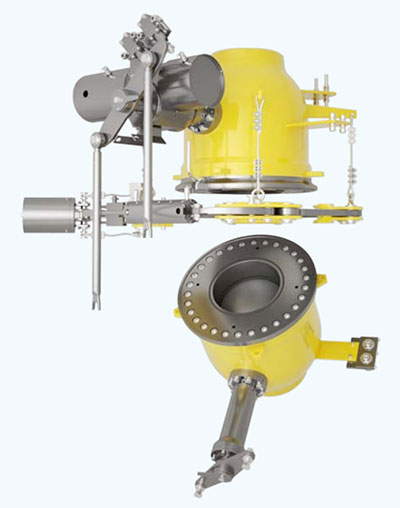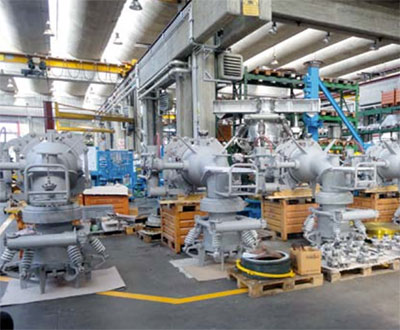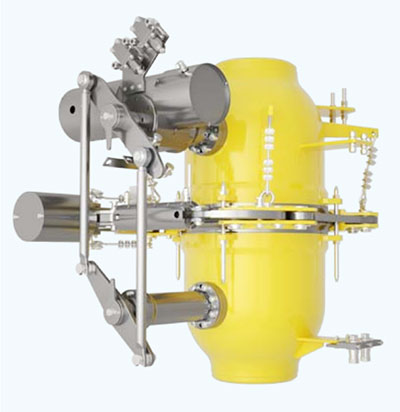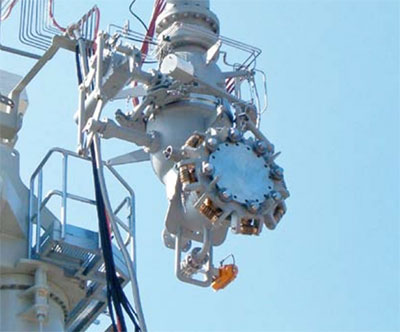DBV/ERC DOUBLE BALL VALVE WITH EMERGENCY RELEASE COUPLING
The Double Ball Valve with Emergency Release Coupling is a safety system that provides protection to the loading/offloading installation and the environment by isolating the product flow and providing quick release under extreme or emergency situations.
Equally suited to rigid marine arms or flexible hoses, the system is hydraulically activated and includes specially developed interlocking system. Already installed in hundreds of terminals world wide.
General
In 1982, it was MIB who supplied the world’s first LNG Double Ball Valve/ Emergency Release Coupling to the industry.
The system consists of two Ball Valves (DBV) held together at their mating flanges by an externally fitted Emergency Release Coupling (ERC).
When an emergency disconnection is activated, the two ball valves close and the emergency release coupler holding the valves together disconnects, allowing the two ball valves to separate.
Upon disconnection the upper valves remain part of and isolate the marine loading arm.
The lower (ship side) valves remain attached to the tanker flange isolating the tanker’s manifold. Spillage of product is thus prevented from both the marine loading arm and tanker’s manifold.
Key Features
• Fully compliant with OCIMF recommendations.
• Valving systems of lightweight construction.
• High integrity sequence / interlock systems.
• Absolute minimum leakage rates at both high and low pressure.
• Operation in extreme iced conditions (up to 50 mm thickness).
• Full and reduced bore options
• Minimum quantity of trapped fluid after valve closure.
• Built-in testing + reassembly aids.
Design
Available for ambient, liquefied low temperature or cryogenic gases, CNG service in diameters from 2" to 20".
High or low pressure designs are available as bespoke solutions for specific installations.
Sizes: 2" to 20"
Pressure rating: ASME B16.5 Cl 150, 300, 400, 900 and Customised
Temperatures: -196 °C up to +250 °C
Fluids: LNG, CNG, LPG, Ethylene, Crude Oil and Petrochemicals
The DBV/ERC is activated by the marine loading arm control system. The speed of operation, i.e. opening/closure of ball valves and the disconnection of the ERC, is adjusted by controlling the flow rate of hydraulic oil from the marine loading arm power pack or via the flow control valve integrated in MIB unit.
The hydraulic actuator for ball valve operation is directly mounted on the loading arm side valve. This actuator also operates the ship side valve by means of a mechanical drive mechanism known as the cross linkage. This cross linkage arrangement gives synchronous operation of the two valves.
The end connections of the cross linkage are ‘Y’ shaped and engage around the pins on the ship side valve lever. The Y shaped ends allow disconnection of the cross linkage when the valves separate. The universal joints built into the cross linkage ensure that there is no risk of hook up during disconnection.
The middle flanges of the ball valves are specially machined for the mounting of the ERC. These middle flanges, which are bolted to the valve bodies, contain the seal(s) that ensure a leak tight connection and house the ball valve seat assemblies.
The ERC consist of a number of clamps held together by connecting rods. The clamps and connecting rods form a collar around the middle flanges. At one end of the collar is a spring pack, at the other end is a releasing fork that engages with pins on the spring pack. The action of moving the releasing fork overcentre in relation to the spring pack connecting rod, causes the springs in the spring pack to be compressed. This provides the necessary clamping forces to overcome internal pressure and external loads applied to the DBV/ERC system.
A shear pin is fitted to the releasing fork to give added security against manual accidental activation. In the event of an emergency release being required, the hydraulic system will first close the ball valves and then disconnect the ERC. The actuation of the ERC hydraulic cylinder breaks the shear pin and moves the releasing fork from the locked to the unlocked position. The stored energy in the spring pack is then released and transmitted via the tie-bar to the clamps, freeing them from the middle flanges. The loading arm side and tanker side valves are now free to separate.




